The reflection nebula vdB69 is illuminated by the Herbig-Bell star HD 288313. These are young A or hotter stars with emission lines. They are also called Herbig Ae/Be stars for this reason. These are surrounded by nebulosity. If no nebulosity is present then they are simply Ae/Be stars. The nebulosity is also known as Parsamian 3 and GN 05.51.0.02. I was unable to find a distance estimate for this nebula but I assume it is likely related to LDN 1622 that fills much of the field and is thought to be about 500 light-years distant. I couldn't begin to fit all of LDN 1622 into my field but the portion sometimes called the "Boogy Man Nebula" did mostly fit in. It continues to the northeast another field or so. I was going to capture that as well and mosaic the two but clouds had other ideas. In fact, they cut short the session so I only got one green frame.
Weather never cooperated sufficiently to try again. Clouds hurt the color data I did get so it is somewhat suspect. In fact, I originally pitched the data as unprocessable but pulled it back from the bit bin and tried one cloudy night to salvage something. It seems severely blue starved for the nebula which came out far redder than others show it yet the star colors were right. I find this happens a lot when hit by clouds as this one was. I probably should have left it mono. This is one I need to try again. The field is located in eastern Orion just east the main parts of Barnard's loop.
14" LX200R @ f/10, L=4x10' RB=2x10' G=1x10', STL-11000XM, Paramount ME
| 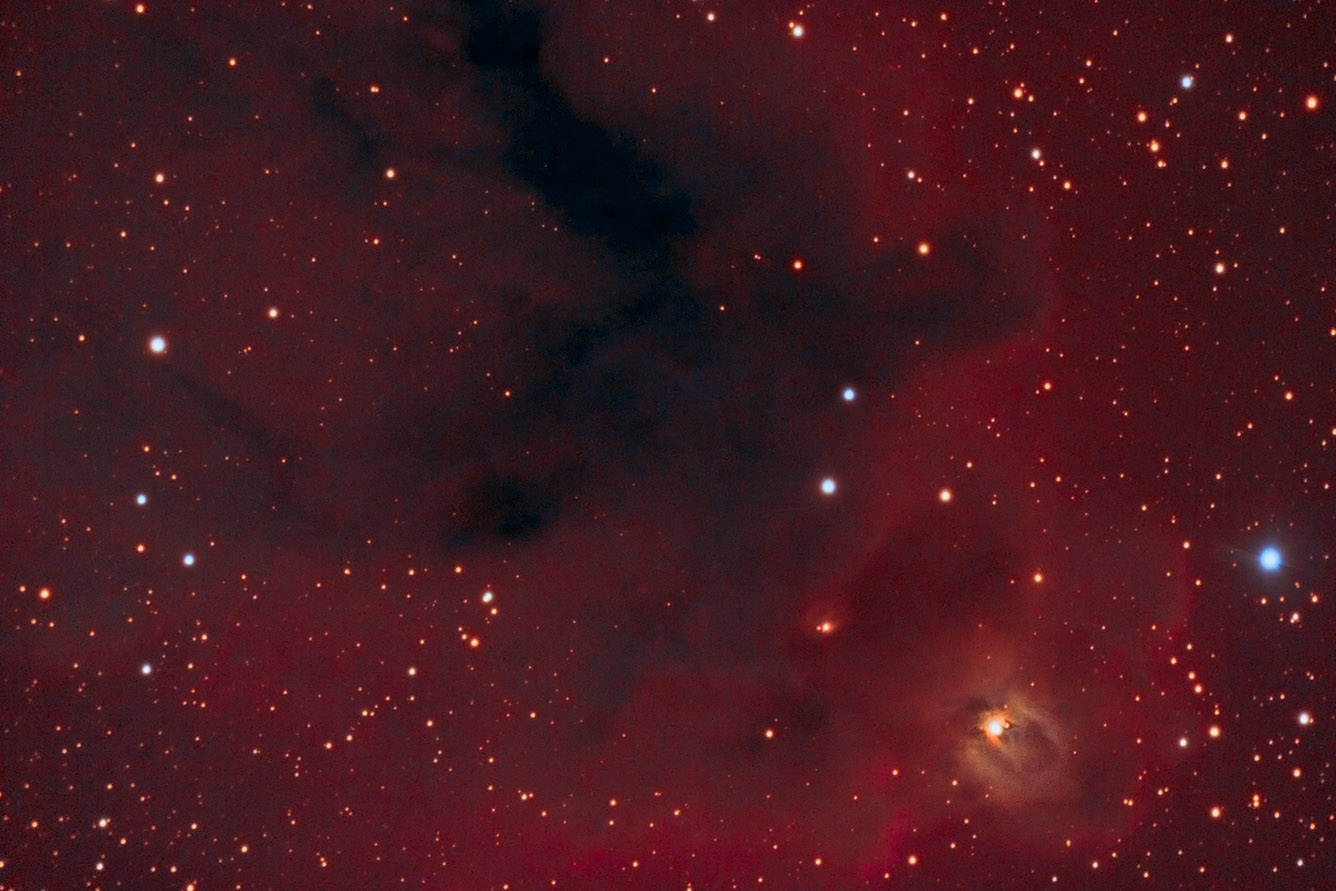
LDN1622L4X10RB2X10G1X10R-67.JPG
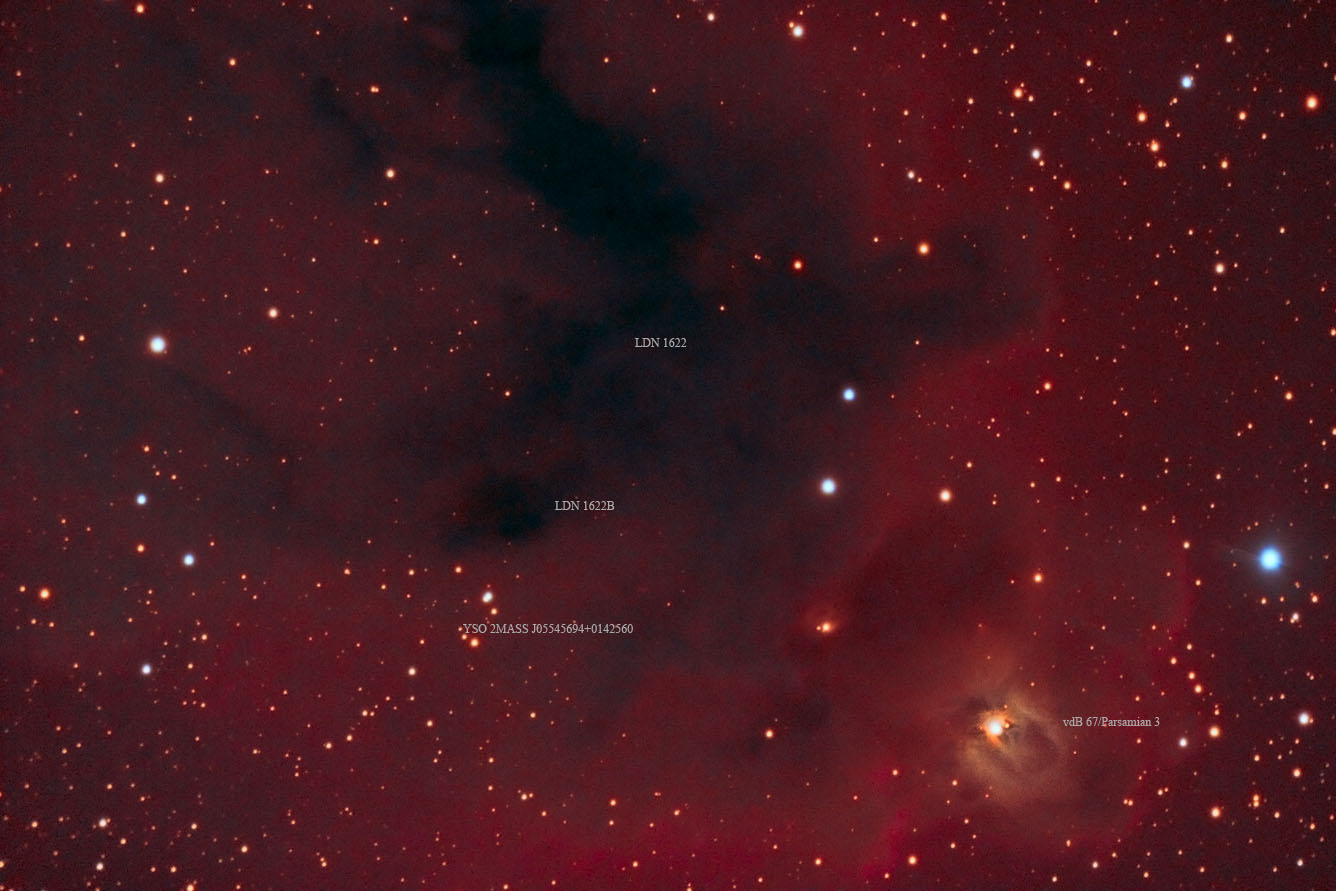
LDN1622L4X10RB2X10G1X10R-67ID.JPG
| Leo I is a dwarf galaxy in our local group of galaxies. Our local group has two large spiral galaxies, M31 and our Milky Way Galaxy, a third much smaller spiral galaxy M33 and 50 more, mostly small dwarf galaxies. Leo I is one of the larger dwarf galaxies. As its name implies it is in Leo -- just north of Regulus. Its glare makes viewing or imaging it a problem. I expected lots of reflection issues but once it was out of the frame at the bottom but not too far out of frame (hence Leo I being low in the frame) I had no reflection issues. But I did have a problem with color gradients as a light leak developed that let light from the red LED on my focuser and the green one on the mount into the camera. At the time I had no way of dealing with those but crude ones. I was very crude with my technique in removing them. I need to dig the old raw data out and reprocess it with today's tools but so far that hasn't happened.
Leo I is thought to be about 800 million light-years distant, about one third the distance to M31 and M33. Being close many of its stars are visible. The galaxy has more carbon stars than most. Being close I was able to pick up a few of them. Not adept at annotating images I only pointed out 5 in the crude annotated image. They aren't all that red as I expected. This might be due to my crude removal of red gradients. Another reason to reprocess this one.
At the time, February 2007, this image set a record for how many asteroids were in the image. Only 5 but it was a lot at the time. Not surprising as the galaxy is very near the ecliptic. Since then I've had 13 and more in a frame but it sure excited me at the time. The brightest is Kasuga. It's naming citation read; "Named in honor of Ryo Kasuga (b. 1950), Japanese Buddhist priest, opera singer, professional magician, television and radio personality. He is also an amateur astronomer, who operates a planetarium at his temple and is very active in the movement against light pollution. Name proposed by the discoverers following a suggestion by T. Sato and A. Fujii."
The asteroid trails show some breaks and uneven intensity levels. Clouds kept interrupting things. With only 35 minutes of data taken in subs too short for my read noise, it came out surprisingly well. Clouds also killed one blue frame totally and hurt all other color frames.
14" LX200R @ f/10, L=7x5' RG=3x5' B=2x5', STL-11000XM, Paramount ME
Related Designations for LEOILeo I, Leo I Dwarf, UGC 05470, DDO 074, CGCG 064-073, CGCG 1005.8+1233, MCG +02-26-027, Regulus Dwarf, KDG 067, [RC2] A1005+12, [RC1] A1006, PGC 029488, UZC J100826.8+121905, Harrington-Wilson #1, [SPB93] 136, [M98j] 104 NED04, LEOI, | 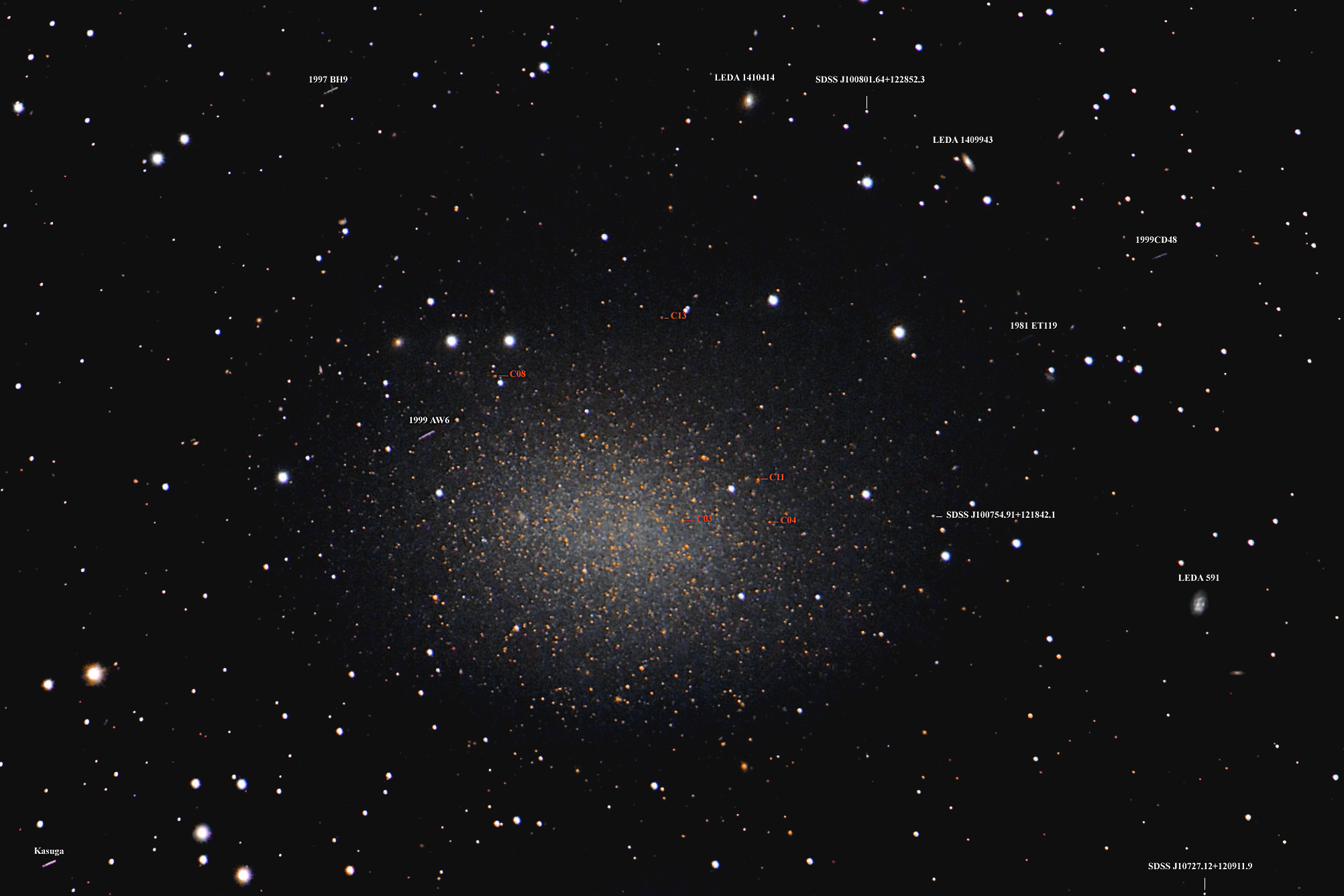
LEO_I_LUM7X5RG3X5B2X5R6a-ID.JPG

LEO_I_LUM7X5RGB2X7R7.JPG
| Leo II is another dwarf member of the Local Group. It is a bit closer than Leo 1 at 700,000 light-years. The star in the center is just a star in our galaxy that happens to line up with the center of the galaxy.
This is another early image. It had a nice asteroid seen against the edge of the galaxy. Often the color data from bright asteroids had nothing behind it so only the luminance trail shows easily. The color data is faint by comparison. I experimented with a way of brightening this portion of the trail. I did this by combining color and luminance data for a pseudo luminance frame. This does help the asteroid but hurts faint stars which get lost in weak color data. That happened to me in this image. I need to reprocess this one.
The asteroid is 16th magnitude Pauldavis. Its naming citation reads; "Named for Paul C. W. Davies (b. 1946), a British mathematical physicist resident in Australia, with research interests in cosmology, quantum gravity, astrophysics and the origin of life, who also has an international reputation as an author and broadcaster. His books range from the scholarly Quantum Fields in Curved Space (with N. D. Birrell) to the popular About Time. He has a long-standing interest in the relationship between science and theology, summarized in his well-known book The Mind of God. His contributions to this field were recognized in 1995 with the award of the Templeton Prize for Progress in Religion. Davies has been a vociferous supporter of the need for search programs for near-earth objects. Name proposed and citation prepared by D. I. Steel and the discoverer."
The break in the trail is due to my Meridian Tree. I knew it would block a part of the image so stopped imaging for the time it was behind the very top of the tree. The blue trail is fainter because the asteroid is quite red in color.
14" LX2004 @ f/10, Pseudo L=3L+2R+2G+2Gx10' RGB=2x10', STL-11000XM, Paramount ME Related Designations for LEOIILeo B, Leo II, Leo II Dwarf Spheroidal, UGC 06253, DDO 093, CGCG 126-111, CGCG 1110.8+2226, MCG +04-27-005, KDG 077, [RC2] A1110+22, [RC1] A1111, PGC 034176, UZC J111327.3+220934, Harrington-Wilson #2, [SPB93] 153, [M98j] 104 NED05, LEOII, | 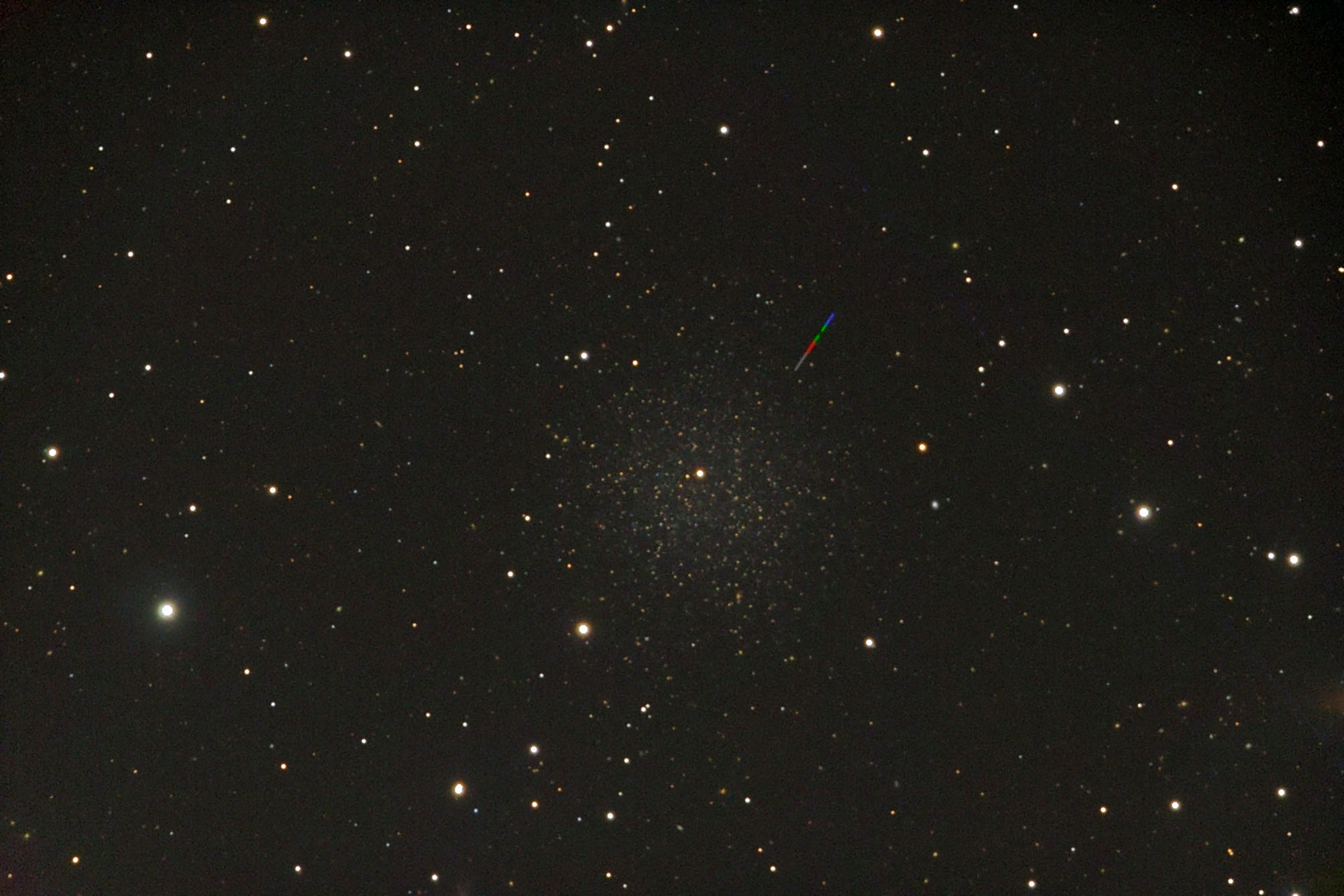
LEO11ADDRL9X10RGB2X10.jpg
| Leo III, also known as Leo A is quite different from Leo I and II. They are rather close at 800 and 700 million light-years. Leo III is over 3 times further away at 2.5 million light-years. This puts it at the distance of M31 and M33 but on the opposite side of the sky. Being so much further resolving its stars is much harder. Fortunately, I'd learned from the first two that I had to overcome read noise and stack properly if I wanted to bring out the stars. In this case, the three brightest stars, one at each end of the galaxy and the third toward the middle and high, are just stars in our galaxy. The brighter real objects in the galaxy are actually star clusters rather than individual stars. These are seen against a background of fine dust of giant stars in the galaxy.
14" LX200R @ f/10, L=4x10' RGB=2x10', STL-11000XM, Paramount ME Related Designations for LEOIIILeo III, UGC 05364, DDO 069, CGCG 153-010, CGCG 0956.4+3059, MCG +05-24-008, Leo A, [RC2] A0956+30, [RC1] A0956, BTS 014, PGC 028868, UZC J095923.7+304457, 11HUGS 173, [SPB93] 120, LEOIII, | 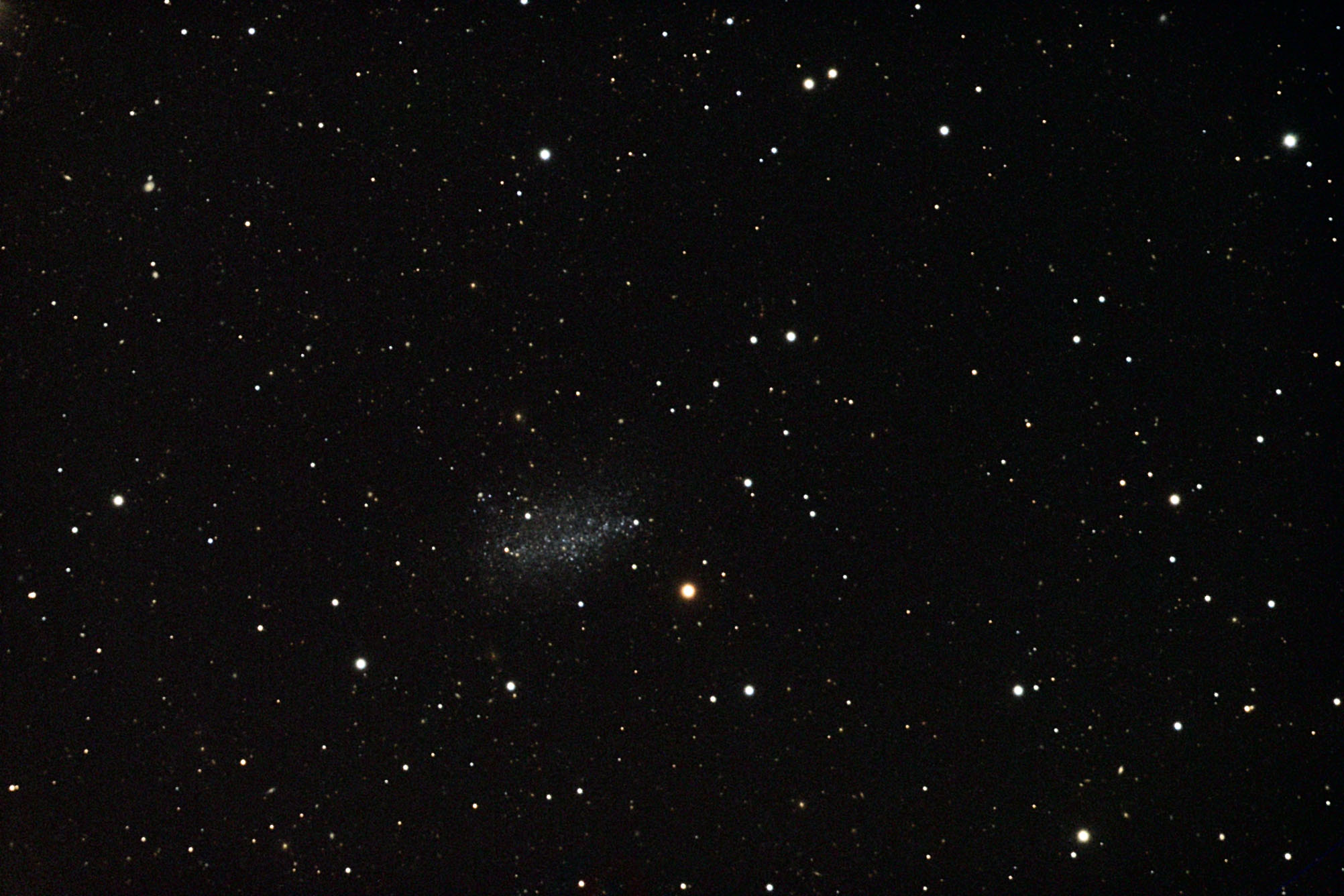
LEOIIIL4X10RGB2X10.jpg
| This is an image Comet Lovejoy as it was fading fast. The weather had prevented me from catching it when brighter. It was up near the head of Draco when this was taken. This is one of my first comet images and I didn't know the correct way to take one or how to process it once taken. The result is that the stars look like a string of Christmas Tree lights and a satellite that passed through a blue image is faintly visible. These detracted from the comet. Today I'd align the stars and remove the comet giving a fixed starfield then align the comet rejecting the stars and then combine. I had no idea how to do this back in 2007. Until I dig out the original data this will have to do.
14" LX200R @ f/10, L=16x1' RGB=10x1, STL-11000XM, Paramount ME Related Designations for LOVEJOYLOVEJOY, | 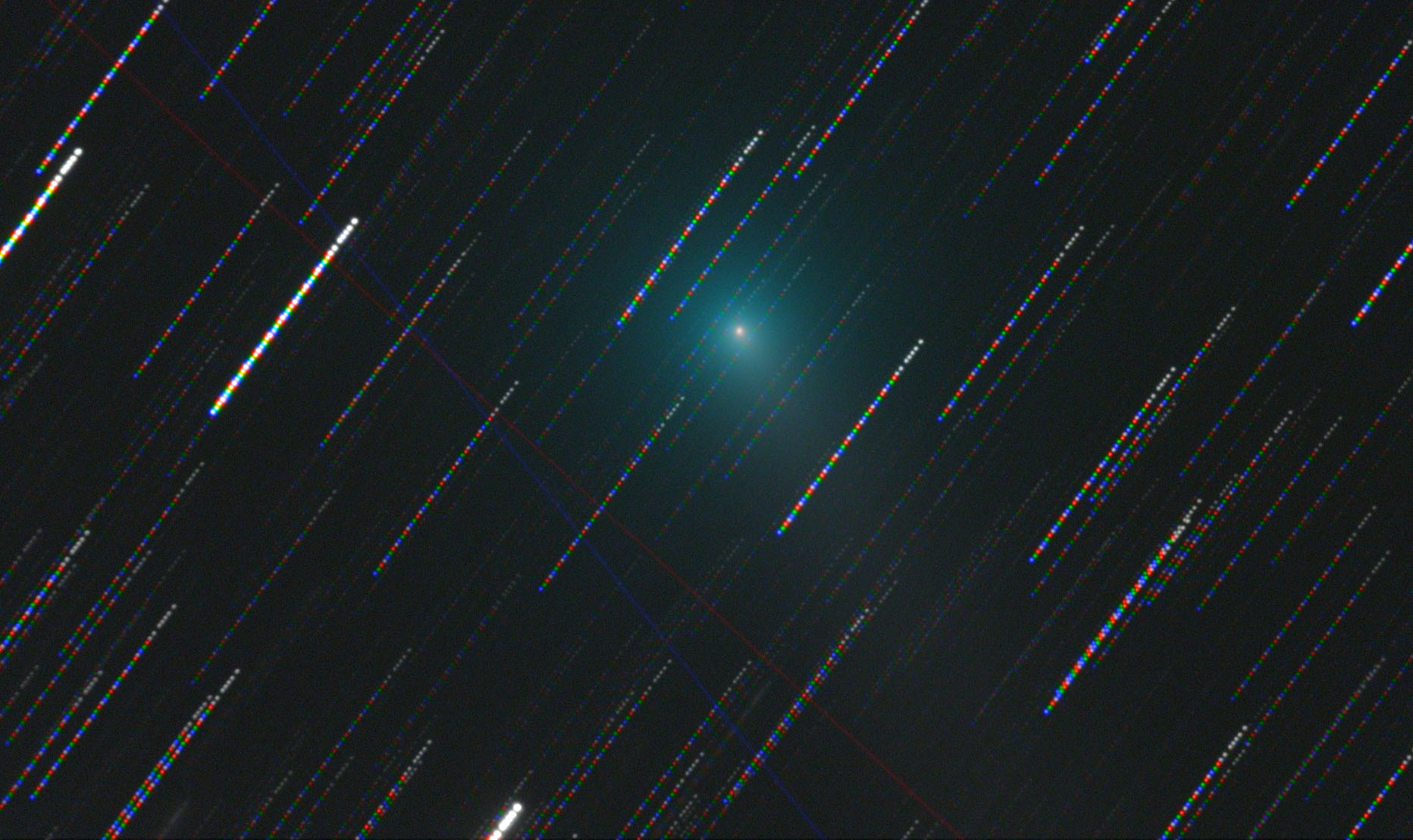
LOVEJOYL46X1RGB10X1.jpg
| M1 is a supernova remnant. It's a bit over 6,000 light-years distant and located by the southern horn of Taurus the bull. The supernova was seen in the year 1054, nearly a thousand years ago though the explosion happened over 7000 years ago, its light has taken over 6000 years just to reach us on earth. The star was crushed into a neutron star by the explosion. It is visible in my image as the dimmer of the two stars near the center of the nebula. It is a pulsar that pulses about 33 times a second. This was first detected at radio frequencies but later Don Taylor's students were able to detect it at visible light frequencies. It was the first and still one of a very few seen to pulsate in visible light as well as at radio frequencies.
It is often called the Crab Nebula because early observers seeing the nebula only in visible light through small telescopes thought it resembled a crab's claw. So why it isn't called the Crab's Claw Nebula I don't know. Too many words?
It was first seen by John Bevis sometime in 1731. Messier stumbled across it on August 28, 1758 while looking for Comet Halley which was making its first predicted return at the time. This then was his first discovery of a comet-like object. He knew it wasn't a comet since it didn't move but recorded it to avoid being fooled by it again. He had to watch it over time to see it didn't move like a comet would wasting valuable comet hunting time. Though like with M2 he wasn't its initial discoverer he did discover it independently not knowing of its prior discovery. M3 is the first he found before anyone else and that was in 1764 some 6 years later. Until then he wasn't actively looking for such objects.
The blue light of the nebula is synchrotron radiation. Light emitted charged particles forced into a curved path by a magnetic field or accelerated in a straight line. It is the former that creates the blue glow here. The pulsars light ionizes the gas expelled by the supernova and the strong magnetic field of the pulsar force these into curved paths creating the blue light. The red is due to ionized hydrogen atoms caused to glow by the extensive ultraviolet light emitted by the pulsar. The light of the nebula is also highly polarized due to the magnetic field but I don't have the filters needed to show this.
This, like many M objects, was a very early image when I moved to digital and I did some things quite wrong in taking the data. Also seeing this night was not very good. Put the two together and it isn't a great image. I reprocessed it a year later which improved things somewhat. Then third reprocessing improved things further. I've attached a crop showing all three. The full image is from the third processing of it. Another for the reshoot list that likely won't happen.
For more on M1 see: http://messier.seds.org/m/m001.html
14" LX200R @ f/10, L=6x5' RGB=3x5', STL-11000XM, Paramount ME Related Designations for M001MESSIER 001, Taurus A, NGC 1952, Crab Nebula, Crab SNR, 3C 144, 4C +21.19, PKS 0531+21, 2MASS J05343194+2200521, IRAS 05315+2158, SSTSL2 J053431.94+220052.1, PKS B0531+219, PKS J0534+2200, 87GB[BWE91] 0531+2159, NVSS J053432+220031, VLSS J0534.5+2202, PSR B0531+21, PSR J0534+2200, DA 179, NRAO 0214, TXS 0531+219, VRO 21.05.01, Cul 0531+219, NEWPS_5yr_5s 142, 2PBC J0534.5+2201, PBC J0534.5+2201, SAXWFC J0534.5+2201.2, 4U 0531+21, 3FGL J0534.5+2201, SWIFT J0534.6+2204, 2FGL J0534.5+2201, 1FGL J0534.5+2200, 0FGL J0534.6+2201, 1AGL J0535+2205, 2EG J0534+2158, 3EG J0534+2200, GEV J0534+2159, [VE75] CL 0531+22, [KRL2007] 047, [TES2010] 017, [BTM2013] 0287, M001, TeV J0534+220, | 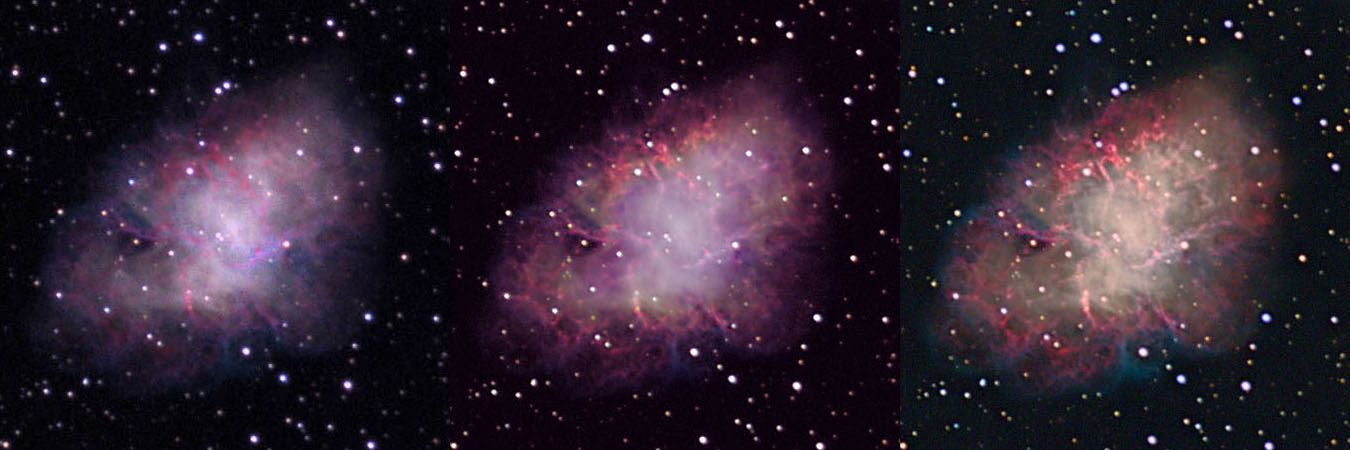
M1-3YEAR.jpg

M1L6X5RGB3X5R.JPG
| M2 is a globular star cluster in Aquarius. It is classified as type II meaning it is quite compact. It is thought to be about 37,500 light-years distant. It has a very elongated orbit. Just how elongated is still up for debate but the latest figures say it can go out over 170,000 light-years and get 165,000 light-years from the galactic plane. It may get within 23,500 light-years of the galaxy's core. My image was taken when I first was getting started in digital imaging then on a poor night. I tried reprocessing it but the data was poor as was the night so this is another for the reshoot list that likely won't happen.
It was first seen by Jean-Dominique Maraldi on September 11, 1746. Messier appears to have independently discovered it September 11, 1760, 4 years before he started to record such objects as a project. Neither saw its stars. That had to wait for William Herschel's much larger telescope. Until then it was just a nebula without stars and thus rather comet-like except it didn't move from night tonight as a comet would.
14" LX200R @ f/10, LRGB=3x15', STL-11000XM, Paramount ME | 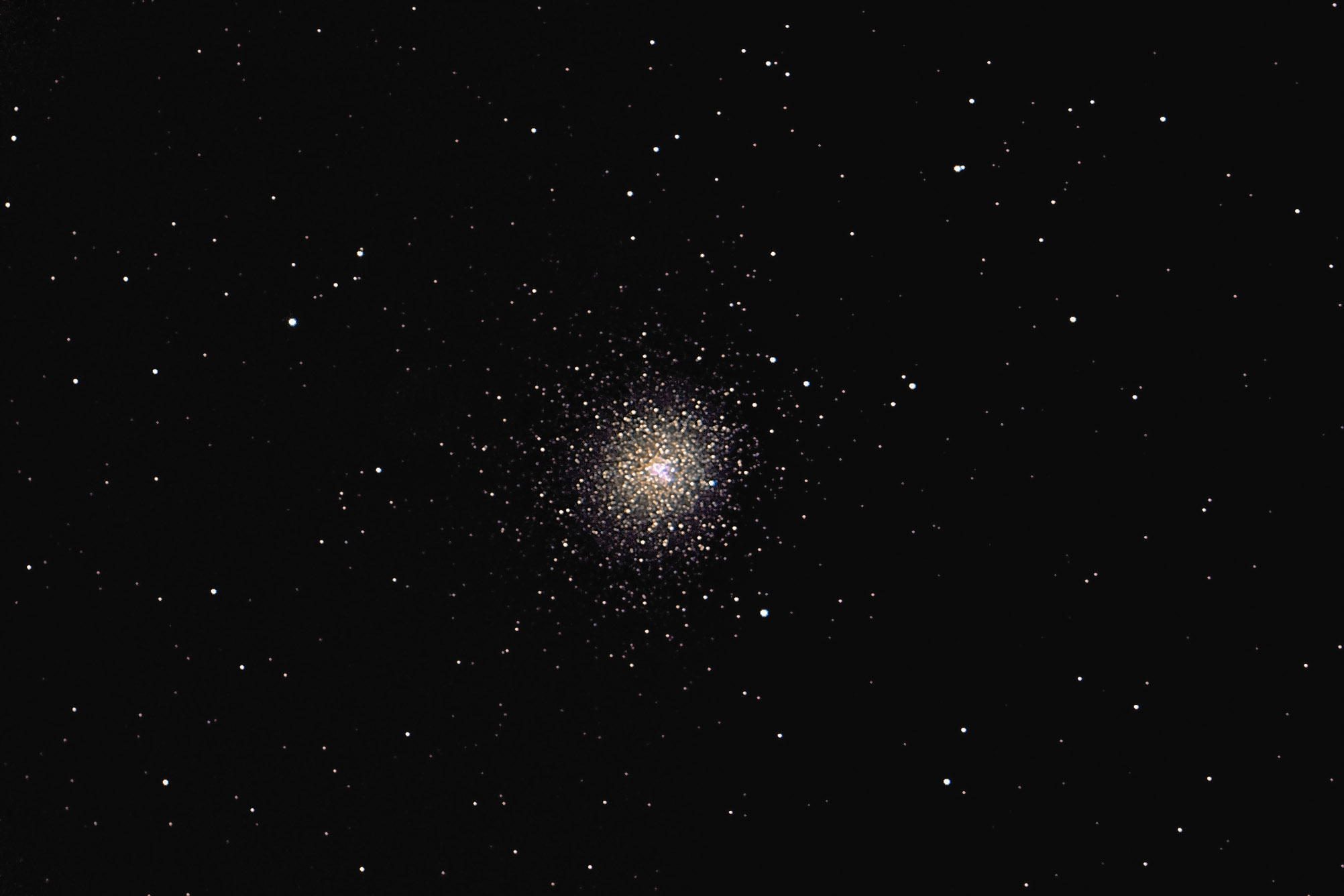
M2LRGB3X5R1.JPG
| M3 is a globular star cluster in Canes Venatici. It is considered one of the showpiece globular star clusters. At about 34 thousand light-years from us and 40 thousand light-years from the galaxy's core, it is a rather distant one to be so famous. It contains a large number of variable (mostly RR Lyrae) stars, over 200. The cluster is about 200 light-years across in deep images and contains some half million stars. The cluster is quite blue due to the large number of "Blue Stragglers" that it contains. It is thought that most globular clusters formed at about the same time as our galaxy, 10 to 11 billion years ago, and that its stars all formed at that time. Yet these "Blue Stragglers" appear to be young stars as stars of their color would live very short lives compared to the age of the cluster. There are several explanations of how these come to be. One is the merger of two or more stars, another is one star stripping gas from another raising its mass enough to turn it blue, still, another says the outer shell of a helium burning star has been stripped away exposing the super hot blue core. Maybe all are involved. With such closely packed stars, it is very difficult to get a good spectrum of these stars which would help to understand this issue.
While Messier had discovered M1 and M2 earlier they'd been first seen by others. M3 is the first in his list that he appears to have discovered before anyone else. He found it on May 3, 1764. As with his globular discoveries, he saw it as a nebula without stars. William Herschel was the first to resolve it, and others, into stars thanks to his telescope with much better light grasp. It appears this object is the one that triggered his desire to hunt down these comet-like objects. While M1 and 2 were logged years before this was the first of 18 he found that year.
See: http://messier.seds.org/m/m003.html for more on this object.
14" LX200R @ f/10. L=4x10' RGB=2x10' STL-11000XM, Paramount ME | 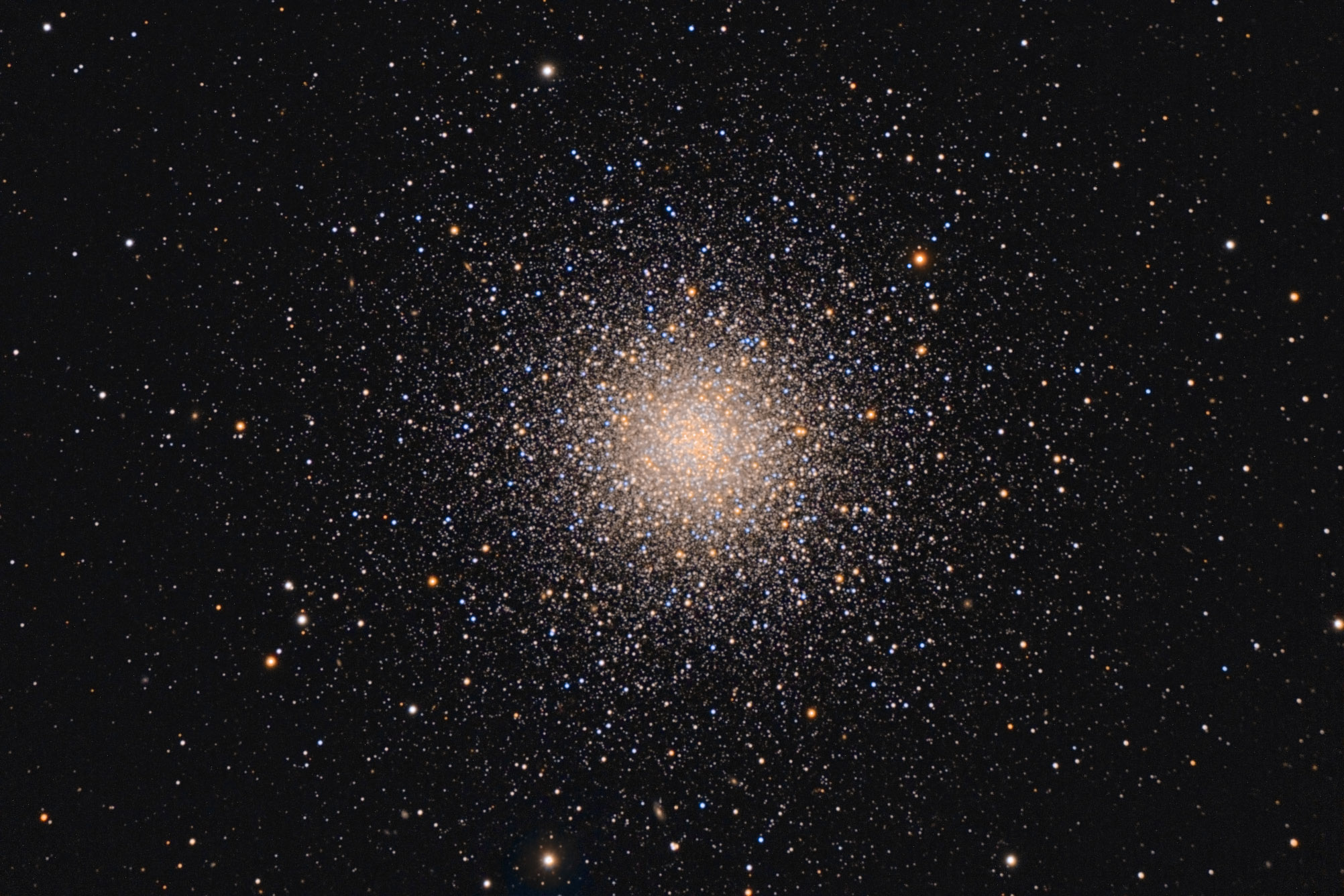
M3L11X5RGB2X10R1.JPG
| M5 is a great globular cluster in Serpens Caput though you'd not know it from my data starved image. Notes indicate clouds were a major issue though so was my ignorance on how to take a globular cluster back in early 2007. To my eye in my 10" scope, it always resembled a crab with an oblong body and star streams forming the legs and claws. None of that is seen in any image I've seen, however. Some sources put its age at nearly the age of the universe, about 13 billion years. Since most put the age of our galaxy as younger than this either the globular isn't as old as thought or it was captured when we tore apart and ate some other even older but smaller galaxy. I vote that it's not quite as old as the 13 billion years often ascribed to the globular. The cluster is about 24,500 light-years distant. It contains an unusually large number of variable stars, at least 105 are known most of the RR Lyra type.
The cluster was first seen by Gottfried Kirch and his wife Maria Margarethe while observing a comet on May 5, 1702. They described it as a "nebulous star". Messier made an independent discovery on May 23, 1764 describing it as: "(A) Beautiful Nebula discovered between the Balance (Libra) and the Serpent, near the star in the Serpent, of 6th magnitude, which is the 5th according to the Catalog of Flamsteed (5 Ser): It doesn't contain any star; it is round, and one sees it very well, in a fine sky with an ordinary refractor of 1-foot". Note that in those days longer refractors had less color so were better than short ones. Aperture, due to the difficulty of getting good glass wasn't really recognized as important in refractors of the time. Later on March 11, 1769 he used "... a good Gregorian telescope of 30 pouces, which magnified 104 times, and I have ensured that it doesn't contain any star." That may not have been such a good telescope by today's standards though what is a 30 pouces telescope? I think it means a scope of about 30 inches in length so again aperture isn't known. (I'm relying on my over half-century old high school French which may be very wrong.)
As mentioned this is a data-starved image of only 7 minutes exposure time through clouds so severely limited. Notes indicate that but for one L and one color frame, all were taken different nights trying to get something through the clouds. Still, it shows more than is seen visually, at least in any telescope I own.
14" LX200R @ f/10, L=7x1' RGB=3x1", STL-11000XM, Paramount ME
| 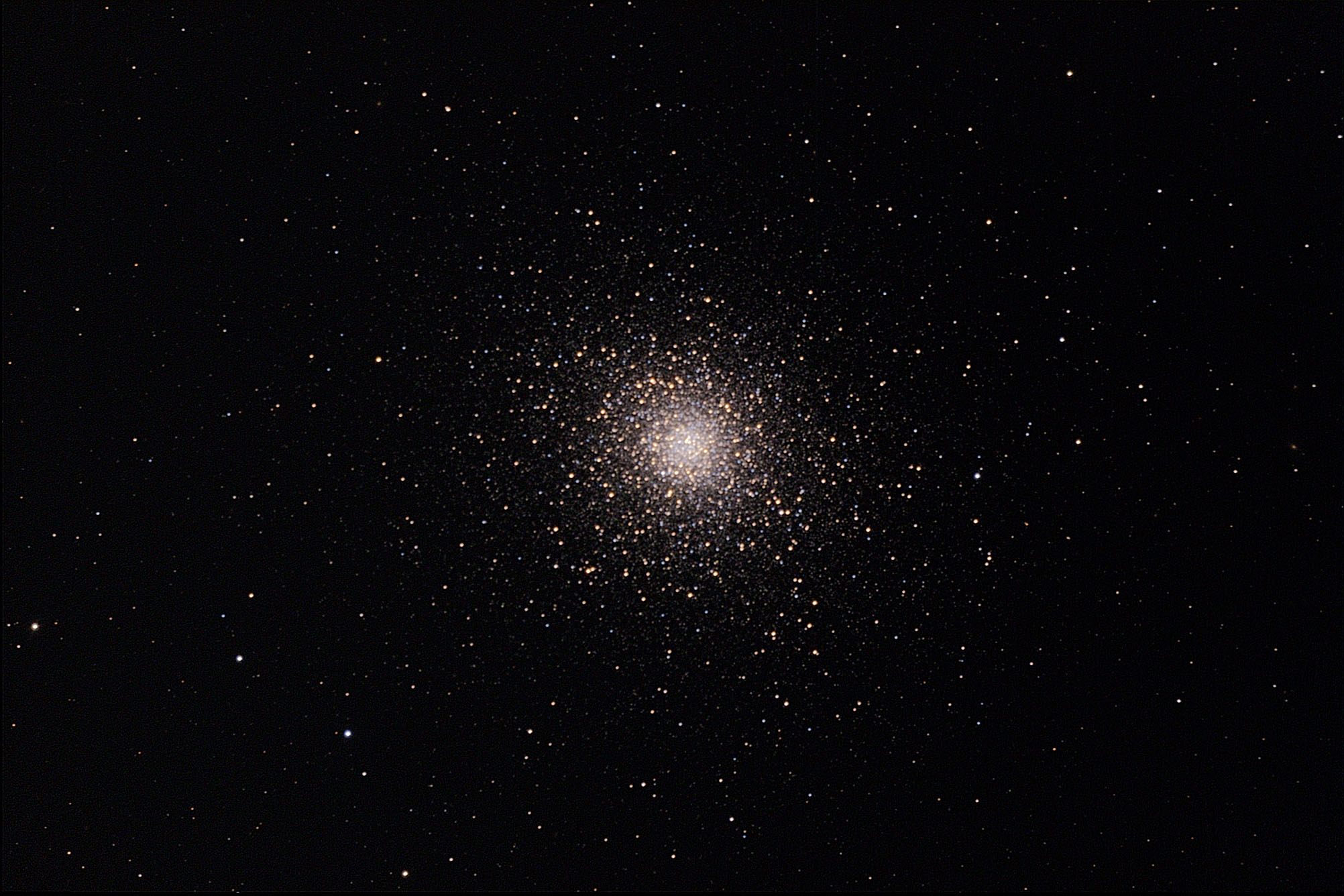
M5L7X1_MLR_RGB3X1.jpg
| M10 is a rather large, in angular size, globular in Ophiuchus about 14,300 light-years from us and about 16,000 light years from the center of the galaxy. Most globulars are rather well endowed with variable stars. Not M-10, it has only 3. While Messier didn't discover many of the entries to his catalog he did discover this one on May 29, 1764. He described it as a "Nebula without stars, very pale." William Herschel was the first to see its true nature as being composed of stars saying "beautiful cluster of extremely compressed stars".
Most Messier globulars are so bright in the core I can't use my standard 10 minute luminance exposure without burning in the core. I was surprised to find that while it appears rather bright to the eye I was still able to use 10 minute luminance exposures. In fact, I'd not intended to use a luminance channel, just a bunch (6 each) of RGB exposures. Unfortunately, my horrid 2012 weather wiped most of those out leaving me with too few. So after several nights of trying I did finally grab 4 luminance frames. Likely part of the reason I could use 10 minute frames was the very poor transparency that night.
There are a couple asteroids in the image. The most obvious is on the left a bit below the centerline. It is (119503) 2001 UR124 at an estimated magnitude of 18.2. Normally such a bright asteroid would really stand out. It is rather dim here due to the poor transparency. The other one is difficult to see. It is near the bottom a bit left of centerline. The left end of the trail is lost in a rather dim star at the apex of 5 dim stars in the pattern of the ^ symbol. It is (69357) 1994 FU at an estimated 19.1 magnitude. There's a third one in the southern part of the cluster but at magnitude 19.7 it didn't survive the color image. I can barely see it in the luminance FITS stack if I use averted imagination. It is (154523) 2003 FF92.
There are several galaxies in the image but only 2 have redshift values. With only two I didn't prepare an annotated image. One is lost among the stars of the globular less than halfway from the core to the edge (6dF J1656595-040746). The other is near the left edge above center and is just a typical small red fuzzy spot. NED lists both with EXACTLY the same redshift. z=0.087107. I find this very unusual. I've never seen this happen even in very dense galaxy clusters. Is one a misprint? That value translates to a light-travel time distance of 1.14 billion light-years using NED's 5 year WMAP calculation.
An HST image of the very center of the cluster in false color can be seen at:
http://www.nasa.gov/mission_pages/hubble/science/cluster-m10.html . The galaxy in the lower right corner of the HST image is not the one in NED. It is much closer to the core. The HST image has north to the left while mine has north at the top.
M10 was one of Messier's discoveries, seen on May 29, 1764. It wasn't until William Herschel recorded it that its stars were first seen.
For a bit more see: http://messier.seds.org/m/m010.html
14" LX200R @ f/10, L=4x10' RG=2x10' B=3x10', STL-11000XM, Paramount ME | 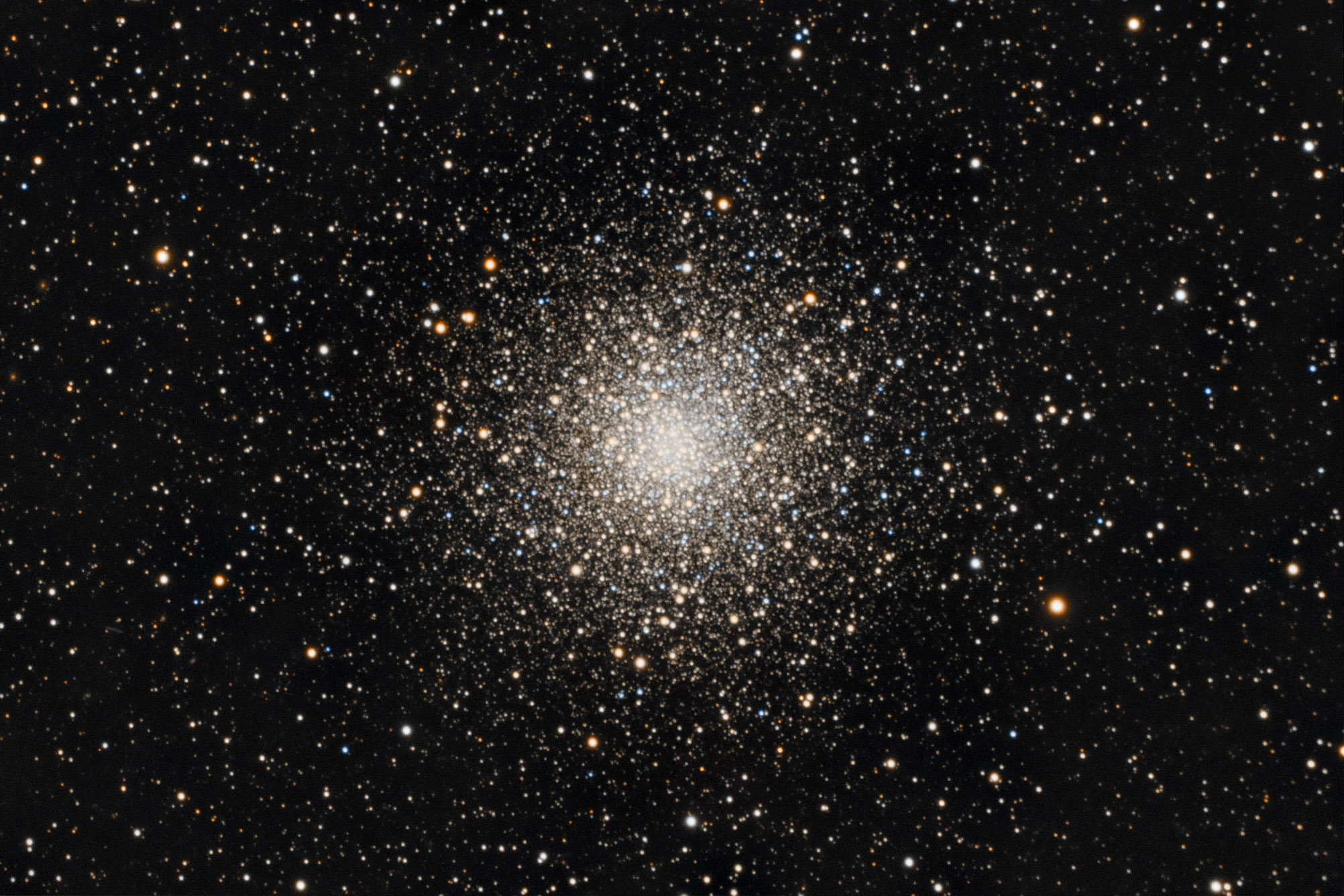
M10L4X10RG2X10B3X10R.JPG
| 











